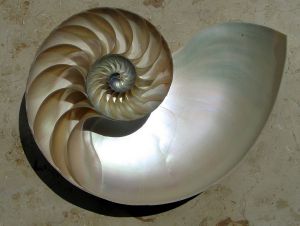The Nautilus has long been prized for its unique shell, to be found in Renaissance Cabinets of curiosities and now sold on eBay for as much as AU$200.

Peter Ward diving at Osprey Reef, off the Great Barrier Reef. Source: Nautilus Magazine
It isn’t hard to see why. Aside from the inherent beauty of the Nautilus, the shell has some enigmatic features that only add to the aesthetics. When cut away, one of the finest natural examples of a logarithmic spiral can be seen. The Nautilus uses these chambers to adjust its buoyancy, by pumping water in and out of the chambers with different salt content and therefore density via osmosis.

Cut away of the Nautilus shell showing the logarithmic spiral. Image: Wikipedia
Professor Peter Ward, on the Environment Institute at Adelaide University, is an internationally renowned palaeontologist and world authority of the Nautilus. He has called for a global ban on the trade of the Nautilus seashell.
“Nautilus has survived every single mass extinction event that’s been thrown at it over half a billion years, now it’s being wiped out by humans to sit on a bathroom shelf or as a pretty button on someone’s shirt,” he says.
Ward has just returned from an expedition in the Philippines where he discovered the Nautilus was close to extinction at known Nautilus fishing sites.
“The Nautilus situation we found in the Philippines was mind-boggling,” says Professor Ward. “The Philippines have been at the centre of Nautilus fishing for decades. Now it is just about extinct there. And it is not just Nautilus. In the same environments we found almost no larger fish at all where there should be large schools of many different species.”
Professor Ward says there is good reason to be concerned about the Nautilus in Western Australian deep reefs, as the largest Nautilus in the world comes from there. “We are seeing them being sold on eBay even though there is supposed to be regulation in Australia”.
“Nautilus is the ‘canary in the coalmine’ of the deep reef environment,” he says. “It tells us about the health of our deeper reefs where little ecological study is done. When Nautilus isn’t there, we know that the other fish at those depths are also at risk from overfishing or other environmental factors. We cannot rule out high acidity and warming of these formerly cool, deep waters caused by climate change, and from rising levels of silt caused by nearby deforestation.”
In the past few years Peter Ward has contributed to the breakthrough discovery that ancient Nautilus pompilius is in fact many separate species, which has overturned the widespread reference to it as a “living fossil.” Ward laments that the human toll on the nautilus may be the last discovery that he ever makes about this remarkable animal.
In his surprisingly emotive piece about a creature for a magazine of the same name, the Nautilus, Ward tells the story of his scientific career researching a creature that has prevailed for 500 million years. It began with his entrancement with the Nautilus shell after first seeing one in a shell shop in Hawaii as a young boy. It ended, albeit only temporarily, with the tragic death of a friend on a diving expedition in New Caledonia.
“Looking back at the myriad decisions, tests, detours, and the rest of the messy contradiction and actions that we call life, I have to marvel at the waves of chance that swept the nautilus and me into its rough seas.” Ward muses.
Ingenious: Peter Ward from Nautilus on Vimeo.
Read more about Peter Ward on the Environment Institute blog here.

